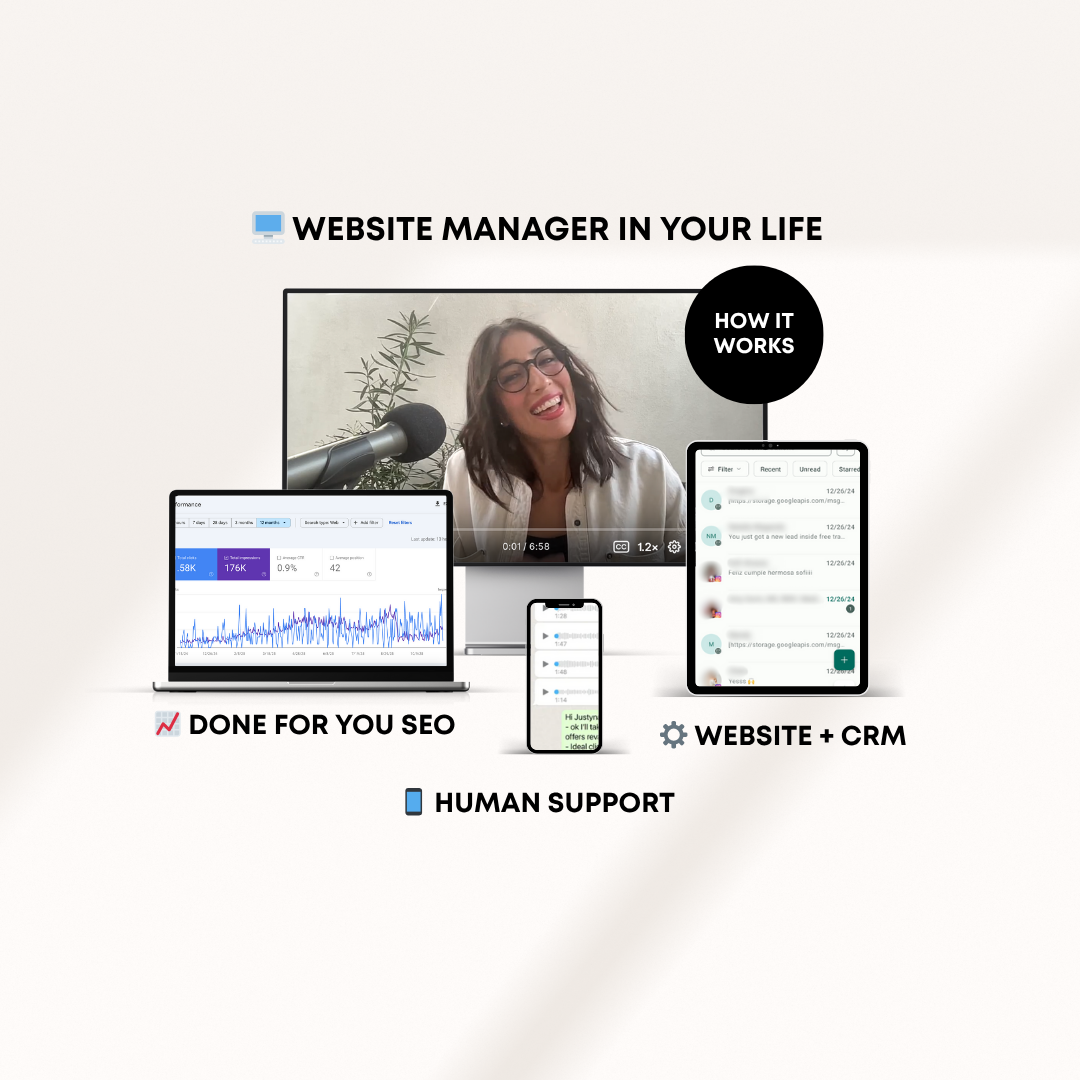HIPAA-Compliant Website: How Therapists Can Stay Secure

If you run a private practice, your website is more than a digital business card. It is often the first place clients interact with you, and sometimes the first place they share sensitive health information. That means your site is not just about design or SEO. It needs to be a HIPAA-Compliant Website that protects client data, builds trust, and keeps you on the right side of the law.
In case you are new here, I am Natalia , and I help private practice owners like you create and manage a strategic, client-attracting website without the tech headaches. If you want a site that brings in clients, protects their data, and works for you while you focus on your practice, you are in the right place. Learn more about how to step away from managing your website on your own and let an expert handle it for you.
What is HIPAA compliance?
HIPAA, the Health Insurance Portability and Accountability Act, sets national standards for protecting patient information, especially electronic Protected Health Information (ePHI). According toHHS.gov, compliance requires administrative, technical, and physical safeguards.
A HIPAA-Compliant Website must:
- Use secure hosting, SSL, and encryption for data in transit and at rest
- Implement access controls, user authentication, and audit logs
- Have clear policies, staff training, and a signed Business Associate Agreement (BAA) with any vendor handling ePHI
Compliance is not a sticker you place on your site. It is a system of protections and agreements that prove you take confidentiality, integrity, and availability of client data seriously.

Are Google Sites HIPAA compliant?
Google Sites are simple and user-friendly, but they are not designed to be a HIPAA-Compliant Website. Google does not list Sites among the services that can be covered by a HIPAA BAA.
You can use Google Sites for a public-facing marketing site, but you should not use it to collect or store client health information. If you want to handle ePHI, you must integrate an external HIPAA-compliant tool such as Jotform HIPAA or Formstack HIPAA that provides a BAA and secure data storage.
The rule is clear: never let ePHI flow directly through Google Sites.
Is Squarespace HIPAA compliant?
Squarespace is a popular platform for building beautiful websites, but it is not HIPAA compliant by default. Squarespace does not claim HIPAA support for its core platform.
The exception isAcuity Scheduling, which can be configured for HIPAA compliance on certain plans. If you are on Premium or Powerhouse and sign a BAA, you can use Acuity to manage health-related scheduling securely.
This does not extend HIPAA compliance to the rest of your Squarespace site. Squarespace forms, contact blocks, and email capture are not designed for ePHI. You can use Squarespace for branding and content, but not for protected health data unless you embed secure, compliant tools.
Are other platforms HIPAA compliant?
Different platforms approach compliance differently. The key is that no mainstream builder is compliant out of the box. You have to configure and integrate correctly.
- Duda: According toDuda their native forms are not HIPAA compliant. You must embed external HIPAA-compliant forms with a signed BAA.
- WordPress and Wix: These can support HIPAA compliance, but only with secure hosting, HIPAA-approved plugins, and proper policies. By default, they are not compliant.
- Specialized tools: Platforms like Jotform HIPAA, Formstack HIPAA, and EHR or telehealth systems are designed for compliance and will sign BAAs. These are the safest way to handle ePHI.
A HIPAA-Compliant Website is possible on many platforms, but only if you integrate secure, approved tools for handling data.
Why a HIPAA-Compliant Website matters for private practice growth
A secure website is not only about avoiding fines. It is also a growth strategy. Clients are becoming more aware of privacy concerns, and they want to know their information is protected before they book a session. Having a HIPAA-Compliant Website signals professionalism, trustworthiness, and credibility.
Think of it this way: your competitors may have sleek designs, but if their site is not compliant, it puts both them and their clients at risk. By prioritizing compliance, you create a competitive advantage. Clients feel safer choosing you, and that sense of safety translates into higher retention and stronger word-of-mouth referrals.
When compliance becomes part of your marketing strategy, your website works harder for you, attracting dream clients who value both expertise and safety.

Common mistakes that make your site non-compliant
Even well-meaning therapists fall into traps that break compliance. Some of the most common mistakes include:
- Using non-secure contact forms that collect client health details without encryption
- Embedding third-party tools that do not provide a BAA
- Assuming SSL certificates are enough to make a site compliant
- Storing client messages or form submissions in email inboxes without proper safeguards
Each of these mistakes can turn a polished site into a liability. The good news is that most of them are fixable with the right tools and systems. Investing in a HIPAA-Compliant Website now protects you from breaches, lawsuits, and reputational damage later.
How to comply with HIPAA
Building a HIPAA-Compliant Website is not just about tech. It is about creating a system that combines policies, training, and tools.HHS.gov highlights these essentials:
- Risk assessment. Document where ePHI lives and your vulnerabilities
- Policies and training. Ensure your team understands procedures and responsibilities
- Technical safeguards. Encryption, access control, audit logs, secure backups
- Business Associate Agreements. Every provider that handles ePHI must sign one
- Monitoring and audits. Review your systems regularly and update them
Compliance is not a one-time project. It is an ongoing process that protects your clients and your practice.
How often does HIPAA need to be reviewed?
HIPAA compliance is not static. The HHS Security Rule requires ongoing review and updates. Best practice is to conduct a risk analysis at least once a year, or whenever you change platforms, add vendors, or launch new services.
Proposed updates in 2025 emphasize more frequent reviews, stronger authentication, and stricter breach notifications. This means that maintaining a HIPAA-Compliant Website requires continuous attention, not just a one-time checklist.

Can My Web Designer Help with HIPAA?
Most web designers focus on aesthetics. They can deliver a polished site that looks professional, but they rarely go beyond visuals. When it comes to compliance, design alone is not enough. Many therapists discover too late that a beautiful site without HIPAA protections is actually a liability.
This is where the difference matters. At Natalia Maganda Web Design for Therapists and Practitioners, we create websites that are not only beautiful and strategic, but also HIPAA-secure and client-centered. We handle the full HIPAA installation for you using trusted tools like HighLevel, so you do not have to touch a line of code, manage subscriptions, or decode legal jargon.
You do not need to sign up separately or juggle multiple platforms. As part of our Website Manager service, we manage everything for you, compliance, security, and ongoing updates. That way, your site is not just functional and beautiful, but also safe for your clients and stress-free for you.
Simple, secure, and designed to keep your focus where it belongs: on your clients, not on tech headaches.

Final Checklist for a HIPAA-Compliant Therapy Website
If you are not sure where to start, use this expanded checklist as a guide to make sure your website and practice are aligned with HIPAA requirements.SimplePractice recommends these steps in its HIPAA compliance checklist, and they align with officialHHS.gov guidance.
Administrative safeguards
- Appoint a Privacy Officer or Security Officer to oversee HIPAA compliance in your practice
- Create written policies and procedures for handling PHI, including email protocols
- Train all staff on HIPAA rules, privacy, and security best practices
- Distribute a “Notice of Privacy Practices” to all clients and keep it updated
- Provide a Release of Information form for client PHI requests
Technical safeguards
- SSL certificate active on every page of your site
- Secure HIPAA-compliant hosting with backups and monitoring
- All forms connected to HIPAA-compliant services with signed BAAs
- Enable two-factor authentication and strong password policies
- Encrypt data in transit and at rest
- Role-based access control with unique staff logins
- Virus protection, patch management, and secure updates
Ongoing compliance
- Conduct annual risk assessments and document vulnerabilities
- Review compliance policies regularly with your team
- Have a written incident response and breach notification plan
- Track and document any suspected violations, including investigation and resolution steps
- Consult with a HIPAA compliance expert if necessary
By following this checklist, you are not only protecting yourself from penalties, you are also creating a HIPAA-Compliant Website and practice environment that reassures clients their privacy is safe with you. A secure website is part of a bigger picture: policies, training, and ongoing monitoring that support both your growth and your clients’ trust.
Final thoughts: Your website is more than marketing
Having a HIPAA-Compliant Website is not just about avoiding fines. It is about showing your clients you value their privacy as much as their progress. When your site is secure, you build deeper trust, attract more of the right clients, and run a business that feels aligned with your values.
And if you are ready to step away from tech stress entirely, explore my done-for-youwebsite management for therapists.
Your website should not only bring clients to you. It should protect them too.
* AI Disclosure: This content may contain sections generated with AI with the purpose of providing you with condensed helpful and relevant content, however all personal opinions are 100% human made as well as the blog post structure, outline and key takeaways.
* Affiliate Disclosure: Some of the links on www.nataliamaganda.com may contain affiliate links meaning that I will get a commission for recommending products at no extra cost to you.

hello! i'm natalia
Latina, web design expert for mental health professionals.
I help ambitious life coaches, therapists and holistic leaders amplify their magic, gain visibility, and simplify their marketing efforts through strategic web design and content.
If you’re looking for an all-in-one system to manage your website, emails, funnels, and CRM, Go HighLevel (affiliate link) is the most powerful tool I’ve tested—and it’s built to grow with you.
On a tighter budget or just starting out? ThriveCart (affiliate link) offers a one-time payment option and easy checkout setups that still pack a punch for digital offers and automation. (Send me an email after your purchase and make sure to use my affiliate link)






